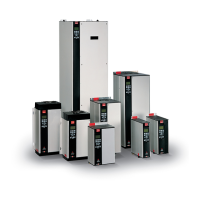VLT
®
5000 SyncPos option
MG.10.J4.02 – VLT is a registered Danfoss trade mark
32
2. A closed-loop PID control. The PID controller
monitors the difference between the actual
position and the setpoint position. Based on
this information it calculates a control signal to
minimize the position deviance. Thus the
SyncPos option is able to compensate for
changes in load or friction. The PID controller
is also necessary to compensate for any posi-
tion deviance caused by inaccurate setting of
the open-loop feed-forward controller.
In short: The feed-forward control is used to handle
changes in the setpoint reference (especially im-
portant in synchronization applications), while the
PID control is used to handle changes in load con-
ditions or inaccuracies of the feed-forward control.
Proportional factor KPROP (11)
The
Proportional factorProportional factor
Proportional factorProportional factor
Proportional factor is multiplied with the posi-
tion deviance and the result is added to the con-
trol signal (the internal speed-reference to the VLT).
Since the calculated control signal is proportional
to the position deviance (or error) this kind of con-
trol is called proportional control. The behavior of
the proportional control is similar to that of a spring
– the further the spring is extended the stronger
the counter-force it produces.
Influence of the
Proportional factorProportional factor
Proportional factorProportional factor
Proportional factor:
KPROP too small large position deviation due to
non-compensatable load and
frictional moment;
KPROP larger quicker reaction, smaller
steady-state deviation, larger
overshoot, lesser damping;
KPROP too great heavy vibrations, instability.
Derivative factor KDER (12)
The
Derivative factorDerivative factor
Derivative factorDerivative factor
Derivative factor is multiplied with the deriva-
tive of the position deviance (the 'velocity' of the
position deviance) and the result is added to the
control signal. The behavior of the derivative con-
trol is similar to that of an absorber – the faster the
absorber is extended the stronger the counter-
force it produces. Thus using the
Derivative factorDerivative factor
Derivative factorDerivative factor
Derivative factor
increases damping in your system.
Influence of the
Derivative factorDerivative factor
Derivative factorDerivative factor
Derivative factor:
KDER small no effect;
KDER larger better dampening, lesser over-
shoot; if KPROP is increased
simultaneously: faster reaction to
control deviation at the same
level of vibration;
KDER too large heavy vibrations, instability.
Integral factor KINT (13)
The sum of all error is calculated every time the
control signal is updated. The
Integral factor Integral factor
Integral factor Integral factor
Integral factor is
then multiplied with the sum of all positioning
errors and added to the overall control signal. Thus
in case that steady-state position errors occurs in
your application, make sure you use the integral
part of the controller. Steady-state errors will be
levelled out as the summed error increases over
time until the control signal eventually matches the
load.
It is possible to set a limit for the control signal
generated by the integral part of the controller (anti-
windup).
Influence of the
Integral factorIntegral factor
Integral factorIntegral factor
Integral factor:
KINT very small steady-state position deviance
is very slowly regulated to zero;
KINT larger faster regulation towards zero
steady-state position deviance,
larger overshoot;
KINT too large heavy vibrations, instability.
Integration limit KILIM (21)
The
Integration limitIntegration limit
Integration limitIntegration limit
Integration limit sets a limit for the control sig-
nal generated by the integral part of the controller.
This helps to prevent the so called "wind-up" pro-
blems which typically occurs in applications where
the overall control signal (the internal speed-refe-
rence) is maxed out for long periods of time.
This feature is also very helpful in applications
where the power to the motor is turned off and on
while the option card is controlling the VLT. Cutting
of power to the motor (by setting terminal 27 low)
while little positioning deviance is present in the
controller, could result in an enormous control
signal being generated once the power is turned
back on.
Velocity Feed-forward FFVEL (36)
The
VV
VV
V
elocity feed-forward elocity feed-forward
elocity feed-forward elocity feed-forward
elocity feed-forward factor is a scaling factor
that is multiplied with the derivative of the setpoint
position (the velocity of the setpoint). The result of
this operation is added to the overall control signal.
This feature is especially useful in applications
where there is a good correlation between the
control signal (the VLT speed reference), and the
speed of the motor. This is indeed the case with
most applications using an asynchronous motor.
Optimizing the PID controller
